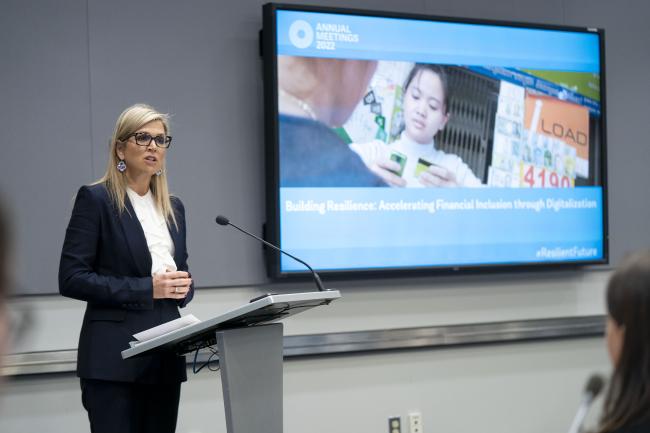
Her Majesty Queen Máxima of the Netherlands, the United Nations Secretary-General’s Special Advocate for Inclusive Finance for Development (UNSGSA), delivered keynote remarks at the Building Resilience: Accelerating Financial Inclusion through Digitalization event during the IMF - World Bank Annual Meetings in Washington D.C. on 15 October 2022.
---
Your Excellencies, Colleagues, Ladies and Gentlemen,
I am thrilled to be here today. It is wonderful to see so many colleagues on the panel whom I have worked with over the years.
Today, more than ever, hundreds of millions of low-income people across the globe need practical tools to help weather the increasing number of economic and weather-related shocks.
Climate change is damaging physical assets, causing income and crop loss, and of course driving food insecurity.
Increasing conflict is forcing a record number of people to be on the move worldwide.
Inflation is wreaking havoc on household budgets.
Considering this outlook, it is clear that the world needs new solutions to really help the most vulnerable build resilience.
As empirical evidence repeatedly underscore, financial inclusion can play a big role.
The updated Global Findex report provides us a fresh opportunity to examine what has worked so far and where our focus needs to be in the years ahead.
Over the last decade, a quarter of the world’s adult population has gained access to financial services.
Fully 71% of adults in developing economies are now included. Today, millions of more women have a financial account – which, for the first time since the Findex launched in 2011, reduced the gender gap in account ownership.
Digital financial services powered much of this growth, backed by investments of course in critical digital public infrastructure – such as greater connectivity and digital IDs.
In India and Kenya, Brazil and Mongolia, the smallest merchants and smallholder farmers receive and make payments with their own mobile phones in their pockets.
Mobile money users are also leveraging their accounts to save and borrow — now 15% of adults in sub-Saharan Africa, for instance, saved using a mobile phone to save money every day. This is amazing.
This is remarkable progress, enabling opportunities previously impossible for millions of underserved people.
Yet, key challenges remain. 1.4 billion people worldwide still don’t have an account. This makes it nearly impossible for them to participate in the digital economy and access tools to build better futures, and be more resilient, of course.
Furthermore, there are millions of adults with accounts that they do not use: 620 million people worldwide still pay bills in cash, including 60 million in Indonesia, 160 million in India, and 30 million in Brazil.
And while the gender gap has narrowed—of course from country to country—three quarters of a billion women are still excluded. Although, the reasons for inequality differ, certain worldwide issues play a role.
For example, women remain far less likely to have an official government ID—which they need to open an account—and fewer women possess a mobile phone or use digital payments. And also women out of work are much more likely to be financially excluded as accounts are often opened to receive wages.
While access has increased, financial wellbeing remains elusive for too many.
Only slightly more than half of all adults in developing economies are financially resilient — meaning, they could reliably come up with extra money within 30 days to deal with an emergency like a job loss, illness, or a natural disaster.
One reason is that in times of financial stress, people often turn to family and friends for help. But when everyone is under the same stress, such as during a pandemic or a drought, social networks can be unreliable.
Emphasizing how financial inclusion can support financial health – notably to help people to better manage their day-to-day finances, to access to credit, and to plan and meet future goals – will be necessary to achieve true change in the lives of the poor. Moving beyond payments and supporting a broad range of services, particularly savings and insurance, can help us get there.
So, where does this leave us as we look ahead, and at a time of multiple crises?
Connecting rural customers to the internet and mobile networks, providing them digital identification, and supporting mobile payment usage through interoperability lay the groundwork for financial inclusion.
Governments can promote financial adoption by digitizing payments for the hundreds of millions of adults who still receive and make payments in cash — whether banked or underbanked.
Consumer protection and financial literacy are a large part of this equation and help underserved customers build skills they need to use products to their own benefit. For example, in low-income sub-Saharan African countries, a third of mobile money account holders need help using their account. This of course makes them vulnerable.
Prioritizing policies that build financial health will help ensure a focus on resilience in the face of growing economic and climate shocks.
For example, public campaigns for families to build buffers through small but frequent savings can really make difference over the long term. We are talking now about building resilience.
Working with fintech providers to develop digital savings products linked to mobile money accounts can create daily opportunities to build up buffers. This in turn gives people the resources needed to invest in improved education, health, and nutrition for their families.
In closing, congratulations on the new edition of the Global Findex 2021—and, of course, the newly published Little Data Book of Financial Inclusion, which I present to you for the first time.
The data it provides will guide efforts in both the public and private sector to deepen financial inclusion over the next 10 years, creating credible economic opportunities for those previously left behind.
Thank you.
